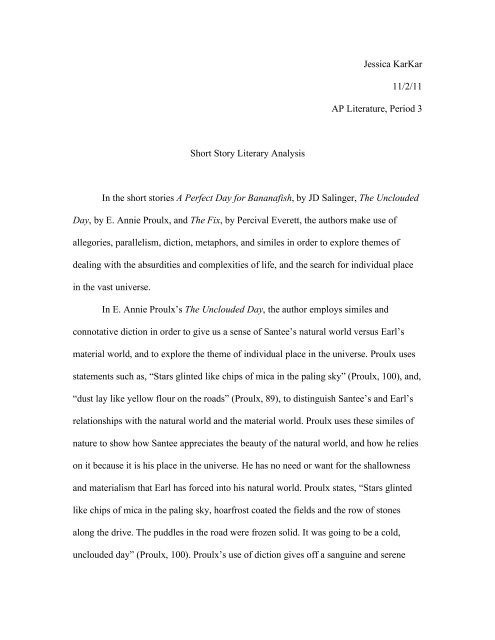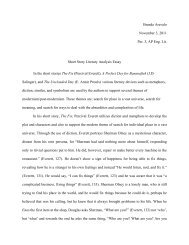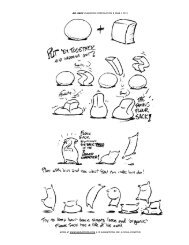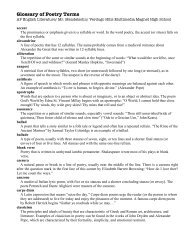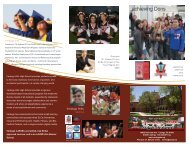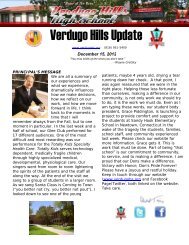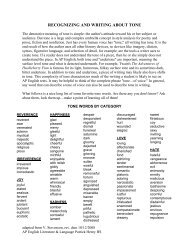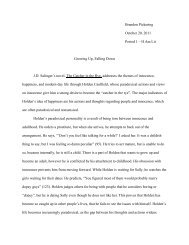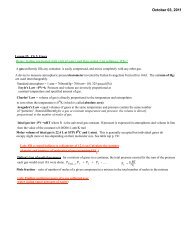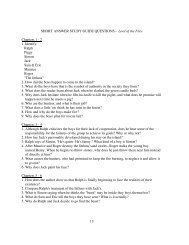Short Story Essay 3
Short Story Essay 3
Short Story Essay 3
You also want an ePaper? Increase the reach of your titles
YUMPU automatically turns print PDFs into web optimized ePapers that Google loves.
Jessica KarKar<br />
11/2/11<br />
AP Literature, Period 3<br />
<strong>Short</strong> <strong>Story</strong> Literary Analysis<br />
In the short stories A Perfect Day for Bananafish, by JD Salinger, The Unclouded<br />
Day, by E. Annie Proulx, and The Fix, by Percival Everett, the authors make use of<br />
allegories, parallelism, diction, metaphors, and similes in order to explore themes of<br />
dealing with the absurdities and complexities of life, and the search for individual place<br />
in the vast universe.<br />
In E. Annie Proulx’s The Unclouded Day, the author employs similes and<br />
connotative diction in order to give us a sense of Santee’s natural world versus Earl’s<br />
material world, and to explore the theme of individual place in the universe. Proulx uses<br />
statements such as, “Stars glinted like chips of mica in the paling sky” (Proulx, 100), and,<br />
“dust lay like yellow flour on the roads” (Proulx, 89), to distinguish Santee’s and Earl’s<br />
relationships with the natural world and the material world. Proulx uses these similes of<br />
nature to show how Santee appreciates the beauty of the natural world, and how he relies<br />
on it because it is his place in the universe. He has no need or want for the shallowness<br />
and materialism that Earl has forced into his natural world. Proulx states, “Stars glinted<br />
like chips of mica in the paling sky, hoarfrost coated the fields and the row of stones<br />
along the drive. The puddles in the road were frozen solid. It was going to be a cold,<br />
unclouded day” (Proulx, 100). Proulx’s use of diction gives off a sanguine and serene
tone. It is a fresh new day, unclouded by Earl. Her use of this connotative diction<br />
throughout the story helps build up the plot through feeling and imagery. Proulx’s use of<br />
these literary devises gives us an in-depth perception of the characters and the theme of<br />
the story.<br />
In A Perfect Day for Bananafish, JD Salinger uses allegory and diction to<br />
formulate the theme of dealing with the absurdities and complexities of life. Salinger<br />
states:<br />
… The girl in 507 had to wait from noon till almost two-thirty to get her call<br />
through. She used the time though. She read an article in a women’s pocket-size<br />
magazine, called “Sex is fun—or Hell.” She washed her comb and brush. She<br />
took the spot out of the skirt of her beige suit. She moved the button on her Saks<br />
blouse. She tweezed out two freshly surfaced hairs on her mole. When the<br />
operator finally rang her room, she was sitting on the window seat and had almost<br />
finished putting lacquer on the nails of her left hand. She was a girl who for a<br />
ringing phone dropped exactly nothing (Salinger, 7).<br />
Salinger’s use of diction helps develop certain characteristics of Muriel, such as her<br />
vanity, materialism, and superiority. Muriel’s self-absorption makes her seem indifferent<br />
to Seymour’s situation. This infers that she doesn’t truly understand Seymour’s tragic<br />
experience, and this occurrence makes Seymour feel like an outsider in her shallow<br />
world. Seymour says:<br />
Well, they swim into a hole where there’s a lot of bananas. They’re very ordinarylooking<br />
fish when they swim in. But once they get in, they behave like pigs. Why,<br />
I’ve known some bananafish to swim into a banana hole and eat as many as<br />
seventy-eight bananas. Naturally after they’re so fat they can’t get out of the hole<br />
again. Can’t fit through the door… I hate to tell you, Sybil. They die… They get<br />
banana fever. It’s a terrible disease (Salinger, 16).<br />
Salinger portrays Seymour’s story of the bananafish as an allegory for Seymour’s<br />
experience in the war. The banana hole represents the war, the bananafish represent
Seymour and the other men who fought in the war, the bananas represent the people that<br />
were killed, and the banana fever represents the loss of innocence, the trauma, and the<br />
build up of guilt that the men suffered after returning home from the war. Seymour could<br />
no longer live with his “banana fever,” and eventually deals with the absurdities and<br />
complexities he faces by dieing, just as the fate of all bananafish. Salinger’s use of<br />
diction and allegory gives us a deeper understanding of the characters, and a broader<br />
insight to the theme of the story.<br />
In The Fix, Percival Everett utilizes parallelism in order to develop the plot, and<br />
the theme of individual place in the vast universe; and metaphors in order to give us a<br />
better understanding of the characters’ actions in the story. Sherman Olney says, “You<br />
have to be careful about what you fix... If you irrigate a desert, you might empty a sea”<br />
(Everett, 133). Everett’s use of metaphors illustrates Sherman’s purpose. By him being<br />
the sea, the people whom he fixes things for would be the desert, so in order to “irrigate a<br />
desert,” sacrifices must be made, and, in this case, that sacrifice was himself; this is his<br />
place, his purpose, in the universe. The story opens with Sherman attempting to escape<br />
two men who are in pursuit of him and his abilities: “… Sherman Olney whom Douglas<br />
had seen beaten to near extinction one night by a couple of silky-looking men who<br />
seemed to know Sherman and wanted something from him,” states Everett (Everett, 121);<br />
and the story closes with Sherman attempting to escape a mob of people who are in<br />
pursuit of him and his abilities: “The masses of people pressed in from either side…<br />
‘Don’t!’ they all screamed. ‘Fix us! Fix us!” (Everett, 134). The author’s use of<br />
parallelism puts an emphasis on the paradoxical behavior of human nature. The two men<br />
in the beginning of the story and the mob at the end are perplexed by Sherman’s abilities,
yet in both situations he and his abilities become so desired that the people don’t realize<br />
that they are destroying the very thing they cherish most. Everett’s use of parallelism and<br />
metaphor helps us decipher the characters’ purposes in the story, and comprehend the<br />
theme of individual place in the universe.<br />
In these short stories, we observe how JD Salinger, E. Annie Proulx, and Percival<br />
Everett explore themes of individual place and the search for ways to deal with life by<br />
using similes, allegories, metaphors, diction, and parallelism. The authors succeed in<br />
making a modern statement about human nature. Certain aspects of human nature<br />
indicated are paradoxical behaviors, greed, and an ambiguous perspective towards life. I<br />
would most definitely recommend these short stories to a selected few who I know would<br />
be as interested as I am in comparing and contrasting our thoughts on the subjects. I<br />
found the exploration of these short stories from the Modern/Post-modern Era to be<br />
rather enjoyable and very insightful.


